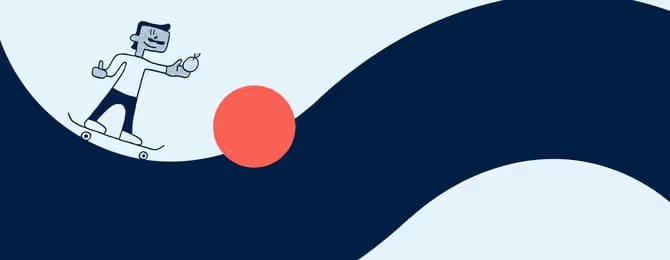How do you balance work and life? 7 tips for modern workers

From flawed to flawless: 5 steps to leading distributed teams

It’s getting harder and harder to separate work from life, especially with all the collaboration tools that keep us connected. But sending Slacks from bed and slurping down lunch on a Zoom aren’t signs of flexibility. They’re signs that boundaries are slipping. And sooner or later, losing the balance of work and life takes a toll on workers’ mental and physical health.
That doesn’t mean you need to get the balance perfect. All you need is a rhythm that makes you feel less stretched thin. Something that lets you do your job well while leaving enough energy to show up for your loved ones. And just as importantly, to show up for yourself.
Everyone’s version of work-life balance looks different. But a few simple habits will bring you less stress, more focus, and real time to recharge.
What is work-life balance?
Work-life balance means having the time and energy to manage your job and your life without one overwhelming the other.
That balance can be hard to find in any work setting. If you’re remote or hybrid, it’s easy to fall into a cycle of always being available. But even in an office setting, late meetings, long commutes, and the pressure to perform can easily cut into your personal life.
With a healthy work-life balance, you don’t have to sacrifice sleep, hobbies, or relationships to get through your to-do list. You still meet deadlines, but not at the expense of your physical or mental health.
Why work-life balance is important — and what happens without it
A lot of people think being available around the clock makes you more committed. In reality, it probably means you’re overworked and running on empty. And the longer that becomes your norm, the harder it gets to stay productive.
When work spills into your evenings, weekends, or even your off-the-clock thoughts, it wears you down. Focus fades, and creativity takes a nosedive. You may still get through your tasks, but as stress builds, your motivation takes a major hit. Over time, burnout sets in, affecting not just you but your whole team.
That’s why work-life balance matters. When you don’t live in a state of constant overwhelm, you can make better decisions and enjoy your work. It becomes easier to speak up, solve problems, and stay engaged. Even little things, like ending the workday on time or taking a real lunch break, make you feel more like yourself.
If you’re a manager, you need to worry about your employees’ happiness and well-being, too. When people have enough space to recharge, they come back with more energy and better ideas. They’re more likely to stick around, help others, and do good work that makes them proud. At the end of the day, establishing boundaries is better for the business than always being on.
7 simple ways to achieve a healthy work-life balance
You don’t need to flip your whole life around to feel a little more balanced. Sometimes the smallest adjustments create the biggest sense of relief. If your days feel like a blur of meetings, pings, and pressure, these work-life balance tips can help.
1. Focus on what actually matters
When everything feels urgent, nothing gets your best energy. Instead of trying to do it all, pick a few tasks that really need your attention. Prioritize those tasks, and let go of the pressure to finish everything at once.
2. Set work hours and honor them
Having a clear stop to your day gives your mind a chance to slow down. Once you’ve reached that time, close the laptop, stop checking your phone, and allow yourself to log off. This is especially important if you lead a team: Managers who take time for their own personal life and hobbies inspire employees to do the same.
3. Use tools that fit your style
Forget the perfect system. Use whatever tools make you feel a little more organized and a lot less stressed. That might be a digital calendar, a paper planner, or simply a sticky note where you prioritize your goals for the day. If it complicates more than it simplifies, it’s not the tool for you.
4. Take actual breaks
Think of breaks as a way to boost productivity, not a reward you have to earn. Even a few minutes away from your desk can reset your focus. So step outside, grab a snack, and move around. Aim for at least one real break every couple of hours to keep your energy up throughout the day.
5. Make time for hobbies
Hobbies aren’t a luxury. They’re part of what keeps you focused, grounded, and resilient at work. Making space for personal interests gives your brain a break from problem-solving mode and lets you reset. Whether it’s painting, playing music, gardening, or meditating, carve out time for whatever helps you feel like yourself.
6. Speak up if you’re stretched too thin
Don’t wait until you're completely overwhelmed to ask for support. A quick conversation about capacity or priorities can go a long way. Try saying something like, “Here’s what I’m currently working on. Can we talk through what’s most urgent?” or “I want to make sure I’m focusing on the right things. Can we revisit my bandwidth this week?” Being proactive shows that you care about doing good work, not that you can’t handle it.
7. Log all the way off
Quiet time matters. When you’re off, be fully off. No refreshing your inbox. No “just checking in.” Give yourself space to be present with something that isn’t work. Even a short break from the digital noise can clear your head in ways you don’t expect.
How employers can contribute to work-life balance
If you're leading a team, you're also shaping the culture people work in every day. And that culture plays a huge part in whether balance feels possible. Even if employees do their part to manage time and set boundaries, it’s hard to make that balance stick without support.
Here are a few ways employers and managers can help.
Normalize time off
People shouldn’t feel like they have to earn rest. Encourage time off, take it yourself, and avoid sending messages during vacations. Everyone breathes a little easier when stepping away becomes the status quo.
Keep an eye on working hours
If folks are skipping lunch or replying late at night, it could be a sign they’re stretched too thin. Don’t assume everything’s fine; check in with curiosity and care. Try asking how their workload feels or if anything’s getting in the way of taking breaks.
More importantly, model healthy habits yourself. Create a culture where logging off on time is expected and respected instead of something to feel guilty about.
Be flexible in a real way
Giving people control over when and how they work shows that you trust them. But true flexibility means they can adjust their schedule without the pressure of being available around the clock. Make sure expectations are clear, and support people in setting boundaries that actually stick. Flexibility should feel like freedom, not another form of overworking.
Talk about the workload
Many employees won’t say they’re overwhelmed until they hit a wall. That’s why it’s important to create space for honest conversations early and often. Use 1:1s to check in on what feels manageable, what’s slipping, and where extra support would be valuable. Normalizing these check-ins builds trust and prevents burnout before it starts.
Support mental health
You don’t need to have all the answers, but showing you care matters. Build trust by staying open, sharing mental health resources, and creating space for real conversations. When employees know it’s safe to speak up, they’re more likely to get the support they need. And that starts with both leaders and HR modeling safety and support from the top down.
Focus on the bigger picture
Work-life balance is only one part of the employee experience. When people feel heard, supported, and trusted, everything improves, from performance to collaboration to morale. A strong employee experience strategy and thoughtful approaches to engagement and retention make it easier to build a workplace where people truly thrive.
Build a better balance with Workleap Officevibe
Work-life balance doesn’t come from time management alone. It’s shaped by the environment people work in. When expectations are clear and feedback flows freely, it’s easier for everyone to find a rhythm that works.
That’s where Workleap Officevibe comes in. Pulse surveys, feedback tools, and engagement insights make it easier for managers to spot early signs of burnout or disconnect. With Officevibe, you can support your people in real time instead of waiting for problems to surface. And that’s one of the first steps toward building the kind of environment where balance actually lasts.
Ready to build a healthier workplace? Try Workleap Officevibe for free or book a demo to learn more.
Give HR and managers the clarity, confidence, and connection to lead better every day.


%20(1).avif)


.avif)
.avif)
%20(1).avif)






